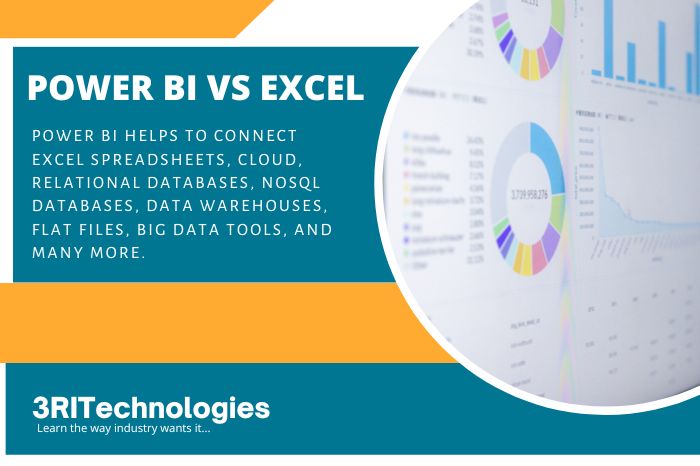In this fast world, we need tools to analyze our data quickly. Now everyone knows the importance of data analysis and how it can be helpful to improve the all over performance and increase revenue. So, it is vital to choose the right tool that is good for you. We know that you are confused between Excel and Power BI. In power BI, BI stands for business intelligence. Do you think what is better for you? So, here we are explaining the difference between excel and power bi.
When comparing Excel vs Power BI, many professionals ask: what is Power BI, and how does it differ from Excel? While Excel remains a foundational tool for data handling, Power BI offers advanced visualizations and dynamic dashboards, making it ideal for modern data analytics. Understanding the difference between Excel and Power BI is essential for anyone working in data-centric roles. You can also explore how to use Power BI in Excel to blend the strengths of both platforms. Take the next step with our expert-led Power BI Online Training at 3RI Technologies to upskill effectively.
First, you should know that excel and power bi both belong to Microsoft and are used for data analysis.
What is Power BI & How Does It Compare with Excel?
Microsoft Excel is an electronic spreadsheet software. With a grid of cells arranged in rows and columns, users can use formulas to format, compute, and organize data. Excel offers data manipulation tools for monitoring, reporting, and analysis. To create intricate models and dashboards, it may import data and link to external data sources.
Users can alter the appearance of their worksheets by adding borders, headers, footers, colors, and fonts using Excel’s formatting features. Calculations using cell references, functions, operators, and constants can be done with formulas.
Excel Macros allows users to record and execute VBA (Visual Basic for Applications) code to automate repetitive activities. All things considered, Excel gives users a flexible and configurable way to store, manipulate,organize, and show data.
What is Power BI?
A business intelligence and analytics application called Power BI makes it simple and straightforward to develop dashboards, generate reports, and analyze data.
The data can then be visualized by users through rich reports that include other graphics such as maps, charts, and key performance indicators. With the help of Power BI Dashboard, you can view important metrics and data quickly by combining several reports and graphics onto one screen.
Businesses may use Power BI to get insights from their data and make more effective decisions. It offers data modeling capabilities to clean up and modify the data, as well as connections to a large range of data sources.
A business intelligence and analytics application called Power BI makes it simple and straightforward to develop dashboards, generate reports, and analyze data.
The data can then be visualized by users through rich reports that include other graphics such as maps, charts, and key performance indicators. With the help of Power BI Dashboard, you can view important metrics and data quickly by combining several reports and graphics onto one screen.
Businesses may use Power BI to get insights from their data and make more effective decisions. It offers data modeling capabilities to clean up and modify the data, as well as connections to a large range of data sources.
Difference between Power BI and Excel
● Excel is part of office 365 and was introduced in 1985, and it upgrades regularly. The recent version of excel is 2018. It was virtual at that time for everyone. Everyone uses excel in their life, whether they are not experts in the data or not working in data analytics. It has a spreadsheet that divides the data into rows and columns and helps calculate using mathematics formulas easily and quickly.
But power BI is a collection of tools, software services, and business intelligence programs. In this, you can connect a large number of data sources of many sizes. It is also used for visualizing, sharing, aggregating, and analyzing data. The Power BI free version is accessible to small and medium-sized business owners; a professional version called Power BI Plus is offered for a monthly membership fee.
Explore your Power BI Skills with Power BI Online Course
● Excel helps you save time by seeing connections in your data and organizing it. It has different types of templates. Excel will enable you to see your data more clearly. Many charts, graphs, and images may help you present your data using sparklines, formatting, and tables to make it easier for others to grasp.
Power BI helps to connect excel spreadsheets, cloud, relational databases, NoSQL databases, Data warehouses, flat files, Big Data tools, and many more. Power BI is exceptionally reliable, easy to use, quick, and enterprise-grade. It can handle in-depth modeling, specialized programming, and real-time analytics. Power BI has three versions: for desktops, software as a service (SaaS), and phones, tablets, or Android.

● Desktop App for Power BI: It will install on the desktop separately. By using this, you can retrieve data from any source. In this app, you have a lot of functions such as power pivot and visualization tools to create reports and dashboards and design the reports that option does not exist in excel.
● Online App for Power BI: Another type of Power BI is an online app. This app allows you to upload the report online, be visible to the team, and intricate with them effortlessly. It has an excellent feature: you can visualize the data on mobile, ios, Android, or in the smartwatch. Using a feature provided by the app, you can simplify visualization for more straightforward navigation and reviewing.
● One of the great features that are not available in excel is that you can share the report via email so everyone can see the changes that you have made in the report.
● Power BI has much more processing speed than excel.
● Microsoft Excel can only handle a certain amount of data, but Power BI can easily manage massive amounts of data.
Learn the Power BI skills online from Industry Expert Trainers only at Power BI Course in Pune
Major Differences Between Power BI and Excel
While Excel gives a user-friendly platform for studying smaller, less complex datasets, Power BI delivers sophisticated capabilities for big data analytics across the company. To get the most of your data, take into account your unique needs and make the most use of each instrument.
Particularly if it has recently switched from Excel to Power BI, Power BI is not adaptable. You can’t be everywhere at all, but Excel can be used to create summary reports with ease using straightforward formulas and processes.
Large volumes of data may be handled by Power BI using the Power Pivot engine paradigm. Most significantly, it is not limited to any particular Office 365 or Excel version. However, Excel finds it difficult to manage big data sets and frequently displays the error message “Not Responding” when dealing with enormous data sets.
Power BI vs Excel: Main Differences
The following tips highlight the key distinctions between Excel and Power BI and present an in-depth comparison of the two programs.
Data Handling
Although they are both business intelligence tools, Excel and Power BI have quite different advantages. Power BI is better at analyzing large datasets and producing insights for the entire company, but Excel is better at editing and formatting smaller datasets.
Data Visualization
Excel and Power BI differ greatly in many ways, one of which is how they handle data visualization. Excel is mostly used for creating static charts and graphs, but Power BI is intended to produce dynamic and interactive representations.
Collaboration
Excel does not provide some of the collaborative tools that Power BI does. Users can collaborate on data analysis by sharing dashboards and reports with other users through Power BI’s cloud-based services.
Power BI vs Excel: Main Similarities
Despite having differing features, Microsoft products Excel and Power BI are both used for data processing and analysis.
The application may quickly and easily carry out computations and mathematical formulas in a spreadsheet-like style by dividing data into rows and columns. Furthermore, it is utilized to convert data sets into visual information, just like Power BI.
In contrast, Power BI is a collection of business-focused software services, tools, and business intelligence applications. Stated differently, Power BI is a platform that, while applicable to various industries, focuses more narrowly than Excel on data processing in commercial settings.
Because they can both retrieve data in various formats and transform it into visual information, Excel and Power BI are very comparable to each other. Furthermore, each new version of Excel and Power BI brings with it new features and enhancements. These updates occur on a regular basis.
Power BI vs Excel: When Should You Use Each?
While Excel gives a user-friendly platform for studying smaller, less complex datasets, Power BI delivers sophisticated capabilities for big data analytics across the company. To get the most of your data, take into account your unique needs and make the most use of each instrument.
The best option between Power BI and Excel depends on the particular data and analysis you require. Complex datasets, dynamic reports, and teamwork are areas in which Power BI shines. If the following are part of your requirements:
• Large data volumes from many sources that are always changing;
• The requirement to find patterns, trends, and anomalies in a vast amount of data;
Utilizing interactive visualizations to examine your data from various perspectives and sharing ideas with other members of your business for easier, ad hoc analysis of medium-sized datasets, Excel is the most effective tool.
If you require:
• The ability to arrange and style data in any way you choose;
• An intuitive and user-friendly spreadsheet interface;
• Compatibility with other Office tools
Excel will then be the more obvious option. For medium sized data projects, Excel provides a flexible, configurable, and productive environment, even though it doesn’t have all of Power BI’s sophisticated analysis features.
Comparative Table
| Item | Power BI | Excel |
| Learning | Power BI is not a simple tool. To use it, one must have a thorough understanding of Power Pivot and Power Query DAX formulas and procedures. | The language used in practically every office in the world is Excel. Since Excel has been around for so long, most users find learning it to be simple. |
| Working Flexibility | Particularly if it has recently switched from Excel to Power BI, Power BI is not adaptable. You are not able to be everywhere at all. | Excel is easy to use and has straightforward formulas and methods for creating summary reports. |
| Size of the Data | Power BI using the Power Pivot engine paradigm may handle large volumes of data. Most significantly, it is not limited to any particular Office 365 or Excel version. | When a lot of data is present, Excel frequently displays the error message “Not Responding” and finds it difficult to manage. |
| Accessibility | Not all places allow you to access Power BI without a license. | Excel is accessible from anywhere and is a user-friendly program for learning dashboard functions. |
Which one is better?
There is no such answer available that can tell us which one is better between power bi and excel. The online functionality and visuals of Power BI are its most vital points. Excel is still a fantastic tool for data analysis and discovery, as well as for presenting data in Pivot Tables. Therefore, the choice of tool truly depends on how the data model will be utilized once it has been constructed. It’s not always simple to respond to the question, either.



